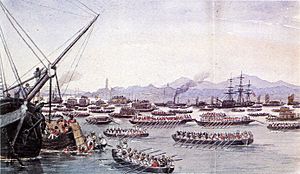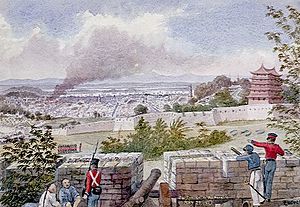Battle of Canton (May 1841) facts for kids
Quick facts for kids Second Battle of Canton |
|||||||
|---|---|---|---|---|---|---|---|
| Part of the First Opium War | |||||||
 The British sailing towards the besieged city on 24 May |
|||||||
|
|||||||
| Belligerents | |||||||
| Commanders and leaders | |||||||
| Hugh Gough | Yishan Yang Fang |
||||||
| Strength | |||||||
| 6,000 2 steamers 7 other ships |
45,000 4 forts |
||||||
| Casualties and losses | |||||||
| 15 killed 112 wounded |
1,000 killed 3,000 wounded 4 forts captured (The Qing acknowledged that 500 Tartar (Manchu) troops were killed and 1,500 wounded on 25 May.) |
||||||
| Casualties source: | |||||||
The Second Battle of Canton (Chinese: 第二次廣州之戰) was a fight between British and Chinese forces. It happened in Canton, China, in May 1841. This battle was part of the larger First Opium War.
Contents
Why Did the Battle Happen?
Canton (now Guangzhou) was a very important city. It was the only port in China where foreign countries, mostly European, were allowed to trade. This system was called the Canton System. For a long time, foreign countries wanted many Chinese goods. These included tea, silk, and porcelain. China, however, did not need many foreign products. This meant China sold much more than it bought.
This changed in the late 1700s. A product called opium began to be shipped into China. It came from farms in India owned by the British East India Company. Soon, foreign countries were selling more to China than they were buying. In 1839, a Chinese official named Lin Zexu tried to stop the opium trade completely. He destroyed a large amount of opium in Canton. This action started the First Opium War.
In response to Lin Zexu's actions, the British Royal Navy attacked Chinese positions near Canton in January 1841. British troops also landed in several places. Local Chinese officials gave up and signed peace agreements with the British. But when these officials took the agreements to Beijing, the capital, they were punished. The Qing dynasty government refused to accept the agreements. They also said that no Chinese land had been lost. Instead, they sent more troops to push back the British.
The Battle Begins
On May 21, Chinese forces tried to surprise the British. They launched a night attack on British positions in the hills north of Canton. But the British fought back and stopped the attack.
By 2:00 AM on May 24, British forces were ready to attack the city. Major General Hugh Gough led these naval and land units. One group, pulled by the steamer Atlanta, had about 330 men. They were to attack and hold the factories. These were special buildings where foreign traders lived and worked. Other warships on the Canton River supported them.
Another group, pulled by the steamer Nemesis, had over 700 soldiers. This group included soldiers from different regiments and Royal Marines. The first group reached its target by 5:00 PM. They got ready to defend or attack.
The Nemesis was slower because it was pulling many boats with troops. It did not reach the riverbank near Tsing-Hae until evening. General Gough landed with his troops. He looked around while other soldiers unloaded cannons from the ships. He later wrote that the hills north of Canton had "four strong forts." The city walls also ran along these hills.
At 3:00 AM, British troops set up their cannons. They were already being fired upon by two Chinese forts. The British then fired back. Under the cover of their artillery, British troops advanced. They moved up a hill towards the nearest fort. Other troops moved forward to protect their sides. General Gough also ordered sailors to attack two western forts.
General Gough had about 6,000 men in total. When the attack signal was given, the troops moved forward. They captured all four forts with few losses. Within half an hour, "British troops looked down on Canton within 100 paces of its walls."
| Fort name | Number of guns |
|---|---|
| Yung-Kang-Tai | 13 |
| She-Tung-Pao | 6 |
| Pa'on-Keih-Tai | 11 |
| Kang-Keih-Tai | 19 |
| Total | 49 |
To the northeast, about 4,000 Chinese troops advanced. They crossed open fields and attacked the British several times. The British pushed them back. Then, at 3:00 PM on May 25, a Chinese general named Yang Fang arrived. He gathered the Chinese troops. General Gough sent more British troops to reinforce his men. The British then defeated the Chinese. They burned down their camp and blew up several storage areas for gunpowder.
Agreement and Aftermath
The British were ready to take the city on the morning of May 26. But at 10:00 AM, a white flag appeared on the city walls. This meant the Chinese wanted to talk about peace. General Gough sent an interpreter to find out what was happening. A Chinese official explained that they wanted peace. Gough said he would only talk to the Chinese general. He also explained that the British did not want this fight. But repeated problems had forced them to attack. He would stop fighting for two hours so their general could meet him.
When no general appeared, the British prepared to attack Canton again the next day. But then, a message arrived from Charles Elliot, a British official. He announced that he had reached an agreement with the governor-general of Canton. The main points of this agreement were:
- China would pay $6 million within one week. The first $1 million was due right away.
- Chinese troops would move at least 60 miles away from Canton.
- British forces would move down the Pearl River to The Bogue.
- The question of giving up Hong Kong would be discussed later.
- Prisoners of war would be exchanged.
General Gough was told to hold his position. What happened next is known as the Sanyuanli incident. A small group of British soldiers were attacked by local Chinese people. These people were upset that foreign troops were in their country. The British saw this as a small fight. But for the Chinese, it became a very important event. Over the years, its story grew and became almost like a legend.
The city of Canton surrendered soon after and paid the British as agreed. Because of this, Canton was not completely destroyed. However, some British soldiers did loot the city after the battle. Chinese troops from other cities left Canton on May 28. At the same time, the British also left. By June 1, all British forces had left the Canton area.
What Happened Next?
Historian Frederick Wakeman said that the Chinese were able to turn their military defeats into a great popular victory. They saw it as a win for the people, even if their government officials were seen as weak. Today, in China, history books for children often tell the story of the Sanyuanli incident. It is seen as a symbol of Chinese resistance.
Even though the battle itself did not change the war much, the Sanyuanli incident had a big effect on the Chinese public. It was the first time that regular people had fought against a foreign power in the history of the Qing dynasty. This showed that people were losing faith in the Qing government. To the Chinese public, the incident showed that if government officials and soldiers could not stop the British, then ordinary people could.
Stories about the incident made people believe that local groups of armed citizens could defeat the British. This also led to a general feeling of unhappiness with the government. This unhappiness later helped cause major rebellions like the Taiping Rebellion and the Boxer Rebellion against the Qing government.
Images for kids






